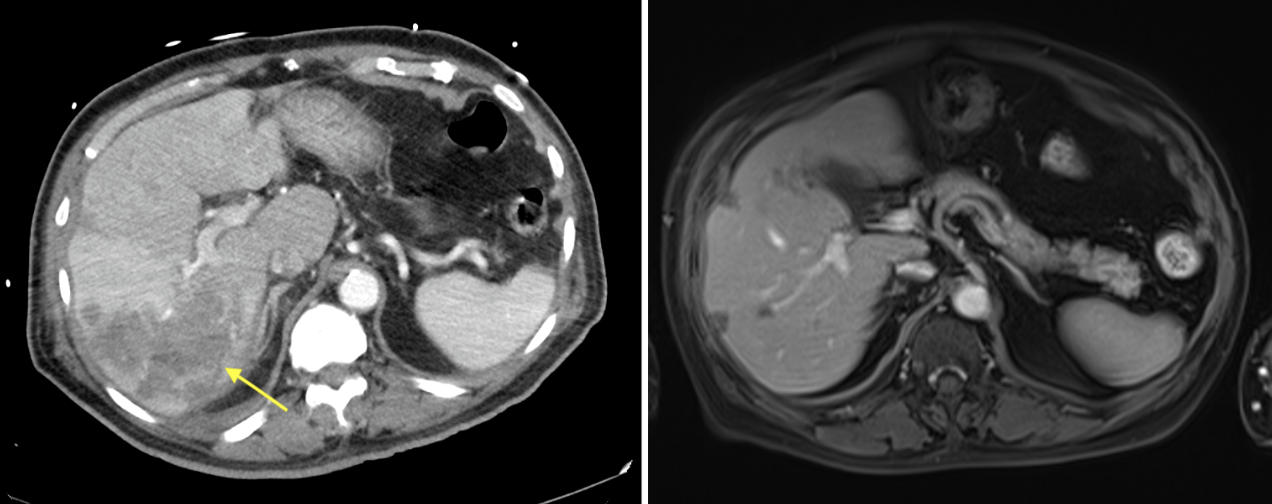Monday Poster Session
Category: Liver
P3939 - Spontaneous Regression of Hepatic Epithelioid Hemangioendothelioma: A Case Report and Review of Management Considerations
Monday, October 27, 2025
10:30 AM - 4:00 PM PDT
Location: Exhibit Hall

Naveena Chittineedi, MD
Northwell Health
Manhasset, NY
Presenting Author(s)
Naveena Chittineedi, MD, Jang Kim, MD, Bryan Taylor, MD, Alvin Htut, MD
Northwell Health, Manhasset, NY
Introduction: Hepatic epithelioid hemangioendothelioma (HEHE) is a rare vascular tumor with low-to-moderate grade malignant potential. HEHE often presents with nonspecific symptoms and imaging findings that mimic metastatic disease making diagnosis challenging. Histopathological confirmation and immunochemistry are essential for definitive diagnosis. While systemic therapy, liver resection, or transplant are common treatments, spontaneous regression can also occur making management complex.
Case Description/
Methods: We report a 78-year-old male from Bangladesh with a history of coronary artery disease, type 2 diabetes, hypertension, and hypothyroidism who presented in late 2018 with decreased appetite and energy. Initial CT imaging revealed multiple hepatic lesions however a liver biopsy was indeterminate. He was readmitted in 2019 for fever and altered mental status. Repeat imaging at that time showed a 9.3 x 7.6 x 11.7 cm heterogeneous mass in the posterior right lobe of the liver, intrahepatic biliary dilatation, and pulmonary nodules. PET/CT scan showed a solitary hypermetabolic hepatic lesion with non-FDG-avid pulmonary nodules. A repeat liver biopsy revealed features consistent with epithelioid hemangioendothelioma, including atypical epithelioid cells with intracytoplasmic lumina and positive staining for CD31, CD34 and FLI-1. Tumor markers (AFP, CA 19-9, DCP) were normal. Follow-up MRI five years later showed that the previously noted dominant hepatic mass had resolved. Confirmatory PET scan also showed resolution of previously seen hypermetabolic lesion in the right hepatic lobe. This patient remained clinically stable without any surgical or systemic intervention.
Discussion: HEHE can follow an unpredictable course ranging anywhere from aggressive progression to spontaneous regression. This case adds to the limited literature on patients whose disease resolved without intervention. Resolution of the dominant hepatic lesion and stability of pulmonary nodules over five years without treatment supports the potential for conservative management in select patients. Identifying which patients may benefit from active surveillance versus immediate intervention remains a critical area of research. In asymptomatic patients with HEHE who have stable or regressing disease on imaging, active surveillance may be a safe and reasonable approach. In conclusion, this case emphasizes the importance of long-term monitoring and individualized care in patients with rare malignancies with variable behavior.

Figure: (Left) CT in Venous Phase showing HEHE (yellow arrow) and (Right) MRI with IV Contrast Showing Resolution of Posterior Right Hepatic Lobe Lesion
Disclosures:
Naveena Chittineedi indicated no relevant financial relationships.
Jang Kim indicated no relevant financial relationships.
Bryan Taylor indicated no relevant financial relationships.
Alvin Htut indicated no relevant financial relationships.
Naveena Chittineedi, MD, Jang Kim, MD, Bryan Taylor, MD, Alvin Htut, MD. P3939 - Spontaneous Regression of Hepatic Epithelioid Hemangioendothelioma: A Case Report and Review of Management Considerations, ACG 2025 Annual Scientific Meeting Abstracts. Phoenix, AZ: American College of Gastroenterology.
Northwell Health, Manhasset, NY
Introduction: Hepatic epithelioid hemangioendothelioma (HEHE) is a rare vascular tumor with low-to-moderate grade malignant potential. HEHE often presents with nonspecific symptoms and imaging findings that mimic metastatic disease making diagnosis challenging. Histopathological confirmation and immunochemistry are essential for definitive diagnosis. While systemic therapy, liver resection, or transplant are common treatments, spontaneous regression can also occur making management complex.
Case Description/
Methods: We report a 78-year-old male from Bangladesh with a history of coronary artery disease, type 2 diabetes, hypertension, and hypothyroidism who presented in late 2018 with decreased appetite and energy. Initial CT imaging revealed multiple hepatic lesions however a liver biopsy was indeterminate. He was readmitted in 2019 for fever and altered mental status. Repeat imaging at that time showed a 9.3 x 7.6 x 11.7 cm heterogeneous mass in the posterior right lobe of the liver, intrahepatic biliary dilatation, and pulmonary nodules. PET/CT scan showed a solitary hypermetabolic hepatic lesion with non-FDG-avid pulmonary nodules. A repeat liver biopsy revealed features consistent with epithelioid hemangioendothelioma, including atypical epithelioid cells with intracytoplasmic lumina and positive staining for CD31, CD34 and FLI-1. Tumor markers (AFP, CA 19-9, DCP) were normal. Follow-up MRI five years later showed that the previously noted dominant hepatic mass had resolved. Confirmatory PET scan also showed resolution of previously seen hypermetabolic lesion in the right hepatic lobe. This patient remained clinically stable without any surgical or systemic intervention.
Discussion: HEHE can follow an unpredictable course ranging anywhere from aggressive progression to spontaneous regression. This case adds to the limited literature on patients whose disease resolved without intervention. Resolution of the dominant hepatic lesion and stability of pulmonary nodules over five years without treatment supports the potential for conservative management in select patients. Identifying which patients may benefit from active surveillance versus immediate intervention remains a critical area of research. In asymptomatic patients with HEHE who have stable or regressing disease on imaging, active surveillance may be a safe and reasonable approach. In conclusion, this case emphasizes the importance of long-term monitoring and individualized care in patients with rare malignancies with variable behavior.

Figure: (Left) CT in Venous Phase showing HEHE (yellow arrow) and (Right) MRI with IV Contrast Showing Resolution of Posterior Right Hepatic Lobe Lesion
Disclosures:
Naveena Chittineedi indicated no relevant financial relationships.
Jang Kim indicated no relevant financial relationships.
Bryan Taylor indicated no relevant financial relationships.
Alvin Htut indicated no relevant financial relationships.
Naveena Chittineedi, MD, Jang Kim, MD, Bryan Taylor, MD, Alvin Htut, MD. P3939 - Spontaneous Regression of Hepatic Epithelioid Hemangioendothelioma: A Case Report and Review of Management Considerations, ACG 2025 Annual Scientific Meeting Abstracts. Phoenix, AZ: American College of Gastroenterology.
